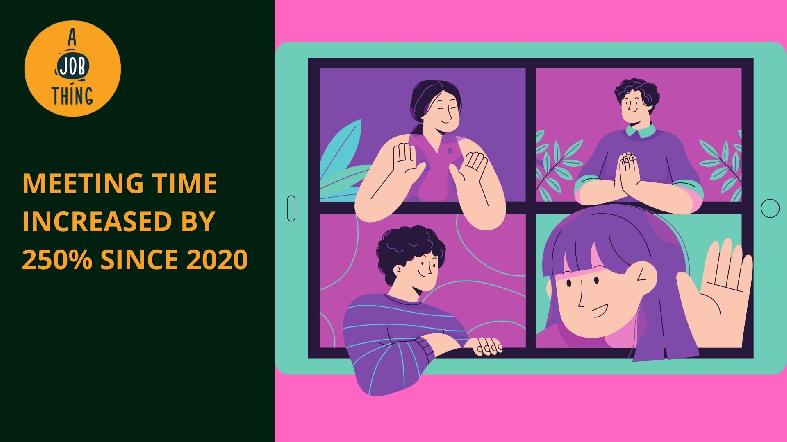
Meeting Time Has Increased 250% Since 2020
Create Job Description Using AI
Write appealing job descriptions for any job opening to attract the most qualifield and suitable candidates. FOR FREE.
try now
Since February 2020, Microsoft Teams users have seen a 252% increase in weekly meeting time.
It's not unexpected that individuals spend more time in meetings; when you're not physically working next to someone, you may need to set aside time to meet with them, even if it's just to ask a quick question. Without a weekly or daily check-in, you could feel like you're in a silo when you're not with your colleagues.
However, just because remote work requires more meetings than office work, it doesn't indicate that every meeting is valuable or productive. Meetings still dominate our lives two years after remote work became a common feature of the modern workforce. They cost companies money, critical productivity time, and negatively damage their culture.
According to Time's HR Identity Crisis survey, meeting culture, "defined by aspects like their frequency, length, and focus — is a top challenge in the workplace. This has worsened significantly as the pandemic progressed."
It's difficult not only for meeting organisers but also for people who have to attend meeting after meeting.
It's not that meetings aren't valuable; it's just that when we've gotten accustomed to them dominating our workdays, it's difficult to know which ones are genuinely productive and what makes a successful meeting.
Here's how to rethink your meetings and make sure they're time well spent by your team:
Reconsider the goal of your meetings
It's tough to modify the pace and purpose of meetings once they've been established. However, if meetings are causing you and your team problems, it's worth intervening and reconsidering all of your meetings to see what should stay, go, or alter.
The stoplight method might be helpful in getting a fast sense of what your meeting's current purpose is. The three stoplight colours: green, yellow, and red, are used by content marketer Jeff Steen to ask other conference attendees how they feel about the meeting.
.jpg)
According to him:
-
"Green" indicates that the meeting was valuable and that they want to be included in future meetings like this;
-
"Yellow" indicates that parts of the meeting were valuable but that the meeting didn't have to be a meeting, or that the attendee is unsure about the meeting's value; and
-
"Red" indicates that the meeting was not valuable at all.
The objective of the stoplight isn't to create a big debate about the meeting's worth but to get a rapid assessment of whether it's working and for whom it's working. After receiving feedback from important stakeholders, you can proceed to the following steps.
Think about how you're going to organise your meetings.
It's not just about changing the "why" but also the "what" of your meetings. A meeting may be valuable, but it may be more valuable depending on the logistics of the meeting, such as:
-
When it is scheduled,
-
How long it will last, and
-
Who will be present.
At 9 a.m., a 15-minute 1:1 meeting is vastly different from an hour-long team meeting at 3 p.m., where participants can turn off their cameras.
First, think about how your meeting will fit into the attendees' daily routines. If there isn't any new development on relevant projects until the middle of the week, a 1:1 check-in might not be as useful at the start of the week.
Attendees at meetings are in the same boat. You don't want to squander someone's time by inviting them into a regular meeting that is just adjacently relevant to them and takes time away from their workflow.
Next, evaluate the meeting's "when."
-
What time does this meeting take place? and
-
How long will it last?
When scheduling a meeting, consider not just the deadlines but also when the meeting attendees work best.
For example, is a brainstorming session better scheduled first thing in the morning or at 4:30 p.m.? How long do you think the meeting will last? What tasks must be completed in concert, and what actions can be completed independently?
Consider whether a meeting is necessary at all.
Meetings are beneficial if held for the right reasons, with the right people, and at the appropriate time. But not everything has to be a meeting, especially in a workforce that has demonstrated how flexibility and asynchronous working can boost productivity and employee wellbeing.
Not all appointments need to be deleted from your calendar, but if a meeting isn't serving a true purpose for you or your team, don't be hesitant to let it go. Instead of a meeting, a weekly email or Slack update could be preferable.
We now have many options to connect with one another because of remote and hybrid work. Let's take advantage of these resources and reclaim some time in the process.





